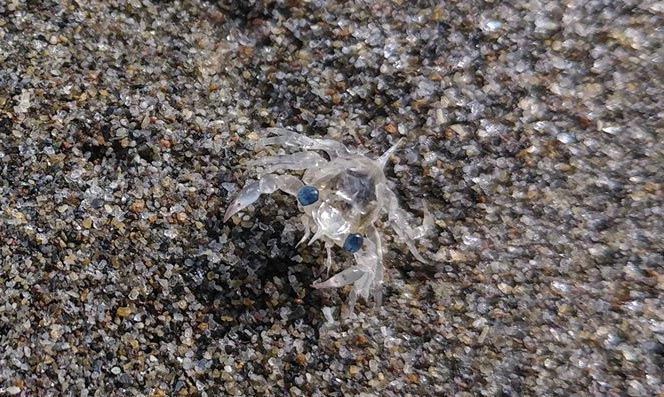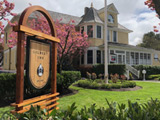Tiny and See-Through on the Oregon Coast: Adorable but Eerie
Published 07/15/020 at 4:24 AM PDT
By Oregon Coast Beach Connection staff

Includes exclusive listings; some specials in winter
In Cannon Beach:
Includes rentals not listed anywhere else
In Manzanita, Wheeler, Rockaway Beach:
Some specials for winter
In Pacific City, Oceanside:
Some specials for winter
In Lincoln City:
Some specials for winter
In Depoe Bay, Gleneden Beach:
Some specials for winter
In Newport:
Look for some specials
In Waldport
Some specials for winter
In Yachats, Florence
Some specials for winter
(Seaside, Oregon) – Remember that alien crab that burst out of people in the Alien movie franchise? Well, this Oregon coast resident isn’t it – but it sometimes looks a bit like that creepy creature of Sci-Fi lore. (Photos courtesy Seaside Aquarium).
This tiny see-through beastie is actually a Dungeness crab, but a very baby one. They go through this stage early in life, becoming eerily transparent but with a dash of blue. Seaside Aquarium’s Tiffany Boothe spotted one a few weeks ago on the north Oregon coast and provided some fun insights into it, calling him an “adorable little guy.”
“Believe it or not this blue-eyed beauty is a Dungeness crab,” Boothe said. “It is currently in a stage of growth called a megalope.”
Each winter, the female Dungeness hosts gobs of larvae inside and then releases them after they’ve hatched. At this point, the little ones are microscopic, Boothe said, a form of larvae called Zoea. Their ability to swim is quite limited so they’re at the mercy of the currents, just riding along where the ocean takes them.
You'll find them along the entire U.S. west coast, and definitely from the southern Oregon coast up through Washington beaches.
“While free-floating, the Zoea will continue to develop,” Boothe said. “They go through six different growth stages before settling down onto the seafloor.”
That sixth and final stage is called megalopal – or megalope singular, megalopae for plural. They graduate (well, grow) to start looking like actual crab, whereas before they've had a kind of almost tadpole look. Boothe said they not only develop legs but claws about now. For awhile they’re still unable to swim in this stage, but eventually they grow a shrimp-like abdomen that makes them good at it.

Boothe said they’re also an important food source for larger creatures like whales or coho salmon.
“Nearshore waters along the Oregon coast see megalopae in high numbers in the late spring and early summer,” she said. “Currents and tides cast them ashore.”
It’s about now they start settling at the bottom or near the bottom of the ocean, where they grow into adulthood. But they’re often spotted along the tideline, as Boothe has captured here, where they burrow into the sand.
“They have also been known to hitch a ride to shore on Velella velella, those stinky blue guys that wash in when the wind blows out of the west,” Boothe said.

Oregon Department of Fish and Wildlife said the megalopae can be found in vast numbers sometimes, but then they have to be in order to survive being eaten or walloped by the tides.
“During their first two years of life they put all their energy into growth and molt up to six times a year,” Boothe said. “By year three their growth rate slows down and they only molt once per year. Their energy is now reserved for reproduction.”
You can find other interesting sea creatures at the Seaside Aquarium, on the Prom in Seaside. 503-738-6211.
Oregon Coast Hotels for this event - Where to eat - Map - Virtual Tour
Cannon Beach Lodging
Nehalem Bay Lodgings
Manzanita Hotels, Lodging
Three Capes Lodging
Pacific City Hotels, Lodging
Lincoln City Lodging
Depoe Bay Lodging
Newport Lodging
Waldport Lodging
Yachats Lodging
Oregon Coast Vacation Rentals
Oregon Coast Lodging Specials
More About Oregon Coast hotels, lodging.....
More About Oregon Coast Restaurants, Dining.....
LATEST Related Oregon Coast Articles
Through 2 a.m. likely best, but some lights possible through dawn June 1 - 2. Space weather, astronomy
Rare Sperm Whale Stranding on N. Oregon Coast, Was Hit by Boat
Showing up near Gearhart, it will decompose naturally. Marine sciences
Coast Guard Barque 'America's Tall Ship' Coming to Portland Rose Fest, N. Ore...
Portland events: June 5 - 8; Astoria events June 13 - 15. Weather
Bright and Active Arietids Meteors May Hit Pre-Dawn Hours of Oregon, Washingt...
Look to east hour before sunrise and you may catch a show. Sciences, astronomy, weather
Why Now Could Be a Great Week for Spotting Killer Whales on Oregon Coast - Video
A good dozen documentations around Depoe Bay, Newport, Coos Bay, Bandon, Tillamook. Marine sciences
Summer Road Work, Traffic Issues Along Oregon Coast Include Astoria, Garibald...
Some daylight closures include bridges, OR 22, OR 18, OR 26, more. Travel tips. Seaside, Cannon Beach, Lincoln City. Travel tips
Pacific City Oregon Weather, 7-Day Forecasts, Live Conditions, Radar, Webcams...
Updated Constantly: Pacific City, Tierra Del Mar, Oregon Weather, Cams, Buoy Observations, Tides, Warnings - Alerts
Oregon Coast Has World's Oldest Harbor Seal, Celebrating 50 Years Soon
June 3 at Oregon Coast Aquarium in Newport. Newport events
Back to Oregon Coast
Contact Advertise on BeachConnection.net
All Content, unless otherwise attributed, copyright BeachConnection.net Unauthorized use or publication is not permitted



















































